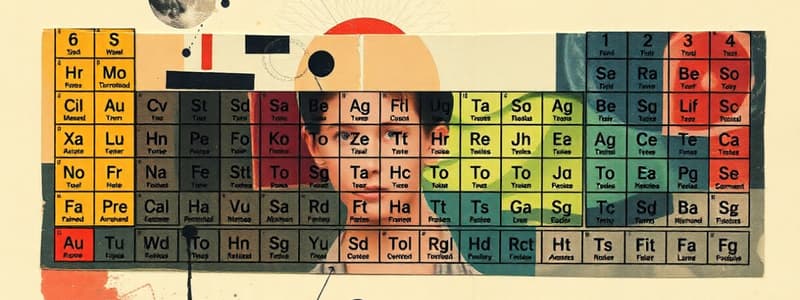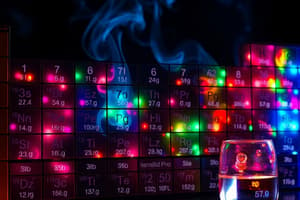Podcast
Questions and Answers
What is the maximum number of electrons that can occupy the third energy level?
What is the maximum number of electrons that can occupy the third energy level?
- 8 (correct)
- 32
- 18
- 2
The elements in the same group of the periodic table have similar chemical properties.
The elements in the same group of the periodic table have similar chemical properties.
True (A)
What is the term for a change from a solid directly to a gas without passing through the liquid state?
What is the term for a change from a solid directly to a gas without passing through the liquid state?
sublimation
In an electron configuration, the notation for the outermost electrons is called the ______.
In an electron configuration, the notation for the outermost electrons is called the ______.
Match the following states of matter with their properties:
Match the following states of matter with their properties:
Which of the following statements best describes the trend in atomic radius as you move from left to right across a period in the periodic table?
Which of the following statements best describes the trend in atomic radius as you move from left to right across a period in the periodic table?
Gases have a fixed shape and volume.
Gases have a fixed shape and volume.
What is the principal quantum number and what does it indicate about an electron?
What is the principal quantum number and what does it indicate about an electron?
The process of changing from a liquid to a gas is called ______.
The process of changing from a liquid to a gas is called ______.
Match the following states of matter with their characteristics:
Match the following states of matter with their characteristics:
Which of the following properties generally increases as you move from top to bottom within a group in the periodic table?
Which of the following properties generally increases as you move from top to bottom within a group in the periodic table?
Electrons in the same energy level have the same energy and can be found in any sublevel.
Electrons in the same energy level have the same energy and can be found in any sublevel.
What term describes the energy needed to remove an electron from an atom?
What term describes the energy needed to remove an electron from an atom?
The process of a substance changing from a solid to a liquid is called ______.
The process of a substance changing from a solid to a liquid is called ______.
Flashcards
What is the periodic table?
What is the periodic table?
The periodic table organizes elements by increasing atomic number and arranges them in rows (periods) and columns (groups) based on recurring chemical properties.
What is electron configuration?
What is electron configuration?
Electron configuration describes the arrangement of electrons in energy levels and sublevels within an atom, following specific rules and principles.
What are properties of matter?
What are properties of matter?
Properties of matter describe the characteristics that distinguish one type of matter from another, including physical properties like color, density, and melting point, and chemical properties like reactivity and flammability.
What are state changes?
What are state changes?
Signup and view all the flashcards
What is energy?
What is energy?
Signup and view all the flashcards
How is the periodic table organized?
How is the periodic table organized?
Signup and view all the flashcards
What are the different types of matter properties?
What are the different types of matter properties?
Signup and view all the flashcards
How do state changes occur?
How do state changes occur?
Signup and view all the flashcards
What is energy and its different forms?
What is energy and its different forms?
Signup and view all the flashcards
Atomic number
Atomic number
Signup and view all the flashcards
Periodic table
Periodic table
Signup and view all the flashcards
Electron configuration
Electron configuration
Signup and view all the flashcards
States of matter
States of matter
Signup and view all the flashcards
Energy
Energy
Signup and view all the flashcards
Study Notes
Periodic Table and Trends
- The periodic table organizes elements based on their atomic number and properties.
- Elements in the same group (vertical column) have similar chemical properties due to similar valence electron configurations.
- Elements in the same period (horizontal row) show gradual changes in properties across the period.
- Atomic radius generally decreases across a period due to increasing nuclear charge and increasing effective nuclear charge.
- Atomic radius generally increases down a group due to increasing electron shells.
- Ionization energy generally increases across a period due to increasing nuclear charge and increasing effective nuclear charge.
- Ionization energy generally decreases down a group due to increasing atomic radius and shielding effect.
- Electronegativity generally increases across a period due to increasing nuclear charge and increasing effective nuclear charge.
- Electronegativity generally decreases down a group due to increasing atomic radius.
- Metallic character generally decreases across a period and increases down a group.
- The periodic table is divided into blocks based on the electronic configuration of the valence electrons.
- These blocks have different chemical and physical properties.
- The periodic table also displays trends in melting points, boiling points and other properties.
- Elements in the same group have similar reactivity.
- Ionisation energy is the energy required to remove an electron.
- Electronegativity is the ability of an atom to attract electrons in a chemical bond.
Electron Configuration
- Electron configuration describes the arrangement of electrons in an atom's energy levels and orbitals.
- Electrons fill orbitals in increasing energy order, following Hund's rule and the Pauli exclusion principle.
- The Aufbau principle states that electrons first fill lower energy levels before filling higher ones.
- Valence electrons are the outermost electrons and determine the chemical properties of an element.
- Core electrons are inner electrons not involved with chemical bonding.
- Different notations exist to represent electron configuration (e.g., spdf notation, noble gas notation).
- Electron configuration influences the reactivity of an element.
- Electron spin is an intrinsic property of electrons.
- Electron configurations explain the placement of elements on the periodic table.
- The number of electrons in orbitals is constrained by the exclusion principle
- The behavior of electrons in an atom is explained by quantum mechanics.
Properties of Matter
- Matter is anything that occupies space and has mass.
- Matter exists in three fundamental states: solid, liquid, and gas.
- Solids have a definite shape and volume.
- Liquids have a definite volume but take the shape of their container.
- Gases have neither a definite shape nor a definite volume.
- Physical properties of matter include color, density, melting point, boiling point, conductivity, and viscosity.
- Chemical properties describe how matter reacts with other substances.
- Physical changes do not alter the chemical composition of a substance.
- Chemical changes result in the formation of new substances.
- Substances have unique sets of physical and chemical properties that define them.
- The properties of matter are affected by various factors, including temperature, pressure, and other external conditions like electromagnetic radiation and magnetic fields.
- The state of matter is affected by temperature.
State Changes
- Matter can transition between different states (solid, liquid, gas) through phase transitions.
- Melting is the transition from solid to liquid.
- Freezing is the transition from liquid to solid.
- Vaporization (boiling) is the transition from liquid to gas.
- Condensation is the transition from gas to liquid.
- Sublimation is the transition from solid to gas.
- Deposition is the transition from gas to solid.
- State changes are influenced by temperature and pressure.
- Phase diagrams are used to visualize the conditions under which different phases of a substance are stable.
- The rate of state changes is temperature dependent.
- Changes in state involve changes in potential energy and intermolecular forces.
Energy
- Energy is the capacity to do work or cause change.
- Kinetic energy is the energy of motion.
- Potential energy is stored energy.
- Forms of energy include mechanical, chemical, thermal, electrical, nuclear, and radiant energy.
- Energy is conserved; it cannot be created or destroyed, only transformed from one form to another.
- Units of energy include Joules (J) and Calories (cal).
- The law of conservation of energy states that energy cannot be created or destroyed, but only transformed from one form to another.
- Energy is fundamental to all processes in the universe.
- Energy can be transferred through various mechanisms, including heat and work.
- The change in thermal energy of a substance is related to the amount of heat added or removed and the mass of the substance.
- Thermodynamics describes the relationship between heat, work, and energy.
- Different forms of energy can be converted into each other with varying degrees of efficiency.
- Energy exchanges between systems and the surrounding environment can be either exothermic (releasing energy) or endothermic (absorbing energy).
- Energy is required for phase changes.
- The amount of energy needed for a phase change depends on the substance and the type of phase change.
Studying That Suits You
Use AI to generate personalized quizzes and flashcards to suit your learning preferences.




